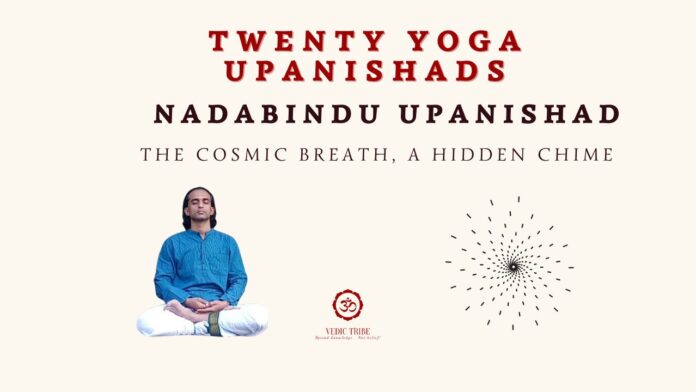What is Vairaja Vidya?
In the previous article, we discussed Tejobindu Upanishad and in this article, we will – Nadabindu Upanishad.
Vairaja indicates a bird and the Pranava (OM) is represented in the form of a supernatural bird for meditation.
This Upanishad contemplates on Viraja Vidya and other models for meditating upon “Om”.
Like other Upanishads it also discusses meditation upon Nada of Om and the state of Jeevanmukti.
Viraja Vidya:
In Atharva Veda, the term “Vairaja” is associated with cow and also Prana. In Mahabharata, it is associated with the primordial being Purusha. However, in this Upanishad, “Om” is presented in the form of a supernatural bird – Vairaja:
– Phonemes A and U are its right and left wings. The phoneme M is its tail.
– Ardha Matra (the half messure at the end of “Om”) is its head. It has three legs: Sattva, Rajas and Tamas.
– Dharma and Adharma are its right and left eyes and the Truth is its body.
– Regions of its legs are Bhu-loka (earthly realm), Bhuvarloka (realm of sky) and Suvarloka (real of outerspace). Jano-loka is its heart and Tapo-loka is its throat. Satyaloka is in its forehead.
Four and twelve matra model of “om”
Upanishad presents “om” in two more models: Four-segment model and twelve-segment model.
Four-segment model: Phoneme A represents Agni, phoneme U represents Vayu, phoneme M represents Surya and the half messure at the end represents Varuna.
Twelve-segment model: Ghoshini, Vidyut, Patangini, Vayu Vegini, Namadheya, Andri, Vaishnavi, Samkari, Mahati, Druti, Nari and Brahmi. This is the feminine representation of “Om”.
The lost knowledge:
It must be noted that the practical knowledge on the meditation methods explained in this Upanishad is now lost. Hence this Upanishad only serves academic interest today.
Jeevanmukti:
The state of “Jeevanmukti” signifies the attainment of moksha (liberation) or enlightenment during one’s lifetime itself. The Upanishad explains certain attributes of such Yogi:
– Devoid of all cares, the Yogi stands like a dead person
– The Yogi does not anymore hear the sound of the conch (shankha) and the large kettle-drum (nagari)
– The Yogi simply perceives the embodied state as a piece of wood
– The Yogi no longer perceives cold or heat, or pain or pleasure, or honour or dishonour
– The Yogi has profound vision without the things to be seen
– Yogi’s prana is motionless without effort
– Yogi’s mind is constant, without anything to rest on
– Yogi completely dissolved in Nada-Brahma
Key takeaways:
– If you are an intermediate practitioner, you may adopt meditation methods mentioned in this Upanishad
– If you are a beginner, you may adopt the attributes of Jeevanmukta to advance your spiritual practices.
In the next article, we will discuss – “Dhyanabindu Upanishad”.
Madhwesh K
Vedic Tribe

